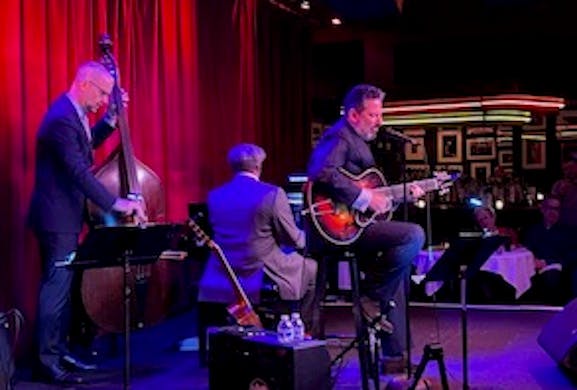The Trio Is the Thing as John Pizzarelli Takes on Broadway and Hollywood
The consummate showman, producer, and player, he maintains a perfect balance between the old and the new, working within the concept of jazz repertory to do things that haven’t been done before.

John Pizzarelli Trio
‘Stage & Screen’
At Birdland Through April 29
More than most contemporary musicians, John Pizzarelli is as talented a producer — and a showman — as he is as a player. Whether on stage or in the recording studio, he knows well how to put together a highly entertaining package that flows organically from start to finish.
His regular working and touring group is his trio, but on albums and other special occasions such as his recent engagement at the Carlyle, he often will either add musicians or work in a different format. In the case of his previous album, “Better Days Ahead (Solo Guitar Takes on Pat Metheny),” he worked in the most intimate possible setting, without other players or even vocals.
The cover of his latest release bears only his name and the title “Stage & Screen.” Based on that information, you might assume that the selling point for this new project would be what we usually call the “concept” behind it, which in this case is a collection of songs from Broadway and Hollywood musicals. That’s a major asset, but to longtime Pizzarelli listeners, the most salient aspect of the latest offering is the ensemble itself.
This is Mr. Pizzarelli’s first official recording with his trio in five years — that is, since his most recent Nat King Cole songbook project, “For Centennial Reasons,” recorded in 2018. Dr. Michael Karn, as Mr. Pizzarelli introduces him, remains the group’s regular bassist, but since 2021 the pianist has been the remarkable Isaiah J. Thompson, who, among other accolades, comes to this week’s run at Birdland having just won an American Pianists Association competition.
The current trio is the major asset of this album — and this is one of the tightest and most together groups currently performing today, in any genre of music. Having said that, I have to also allow that the theme is pretty terrific. In the 1950s, it seemed like every third album by any even vaguely pop-oriented singer or band was either a Broadway or Hollywood songbook – and understandably so, because they always made for great material. In Mr. Pizzarelli’s case, this allows for a particularly wide range of excellent songs, ranging chronologically from the 1925 “I Want to Be Happy” to the 2013 “I Love Betsy.”
What’s especially satisfying about the trio’s approach to this repertoire is that it places all of it on a level playing field. Songs like “Time After Time” and “Where or When” became instant jazz standards, not least because they lent themselves to a variety of styles. Now “Coffee in a Cardboard Cup” and “I Love Betsy” are also swinging like vintage jazz perennials. That’s what those songwriters were going for, and that’s what the Pizzarelli trio provides them with.
Mr. Pizzarelli maintains a perfect balance between the old and the new, working within the concept of jazz repertory to do things that haven’t been done before. The most personal moment of the project is actually based on an iconic jazz performance, Bill Evans’s take on Leonard Bernstein’s “Some Other Time.”
Evans essentially boiled the song down into two modal chords that he turned into a slow vamp, which also became a composition unto itself (titled “Peace Piece”). Mr. Pizzarelli incorporates both into his interpretation, in which he effectively plays a classic piano solo on his seven-string guitar.
Likewise, what he has titled “The ‘Oklahoma’ Suite” is like a new overture to that classic show as interpreted for the idiom of jazz trio — starting with “Oh What a Beautiful Morning” as played arco by Mr. Karn, moo-ing like one of those cattle that are standing like statues. It ingeniously moves from a 1943 Richard Rodgers waltz to something more like a Miles Davis waltz circa 1964, and then transitions from one classic theme to another, all solidly relocated within the swing idiom.
Mr. Pizzarelli’s solo recalls those Oklahoma-bred jazz guitar greats Charlie Christian and Barney Kessel. Meanwhile, “Tea for Two” starts with the verse in tempo and then switches to the chorus in rubato, which is the reverse of the way most songs are customarily done.
Near the end of the album and the show, he sings “As Time Goes By,” both verse and chorus in a medium slow tempo dance tempo. The message, when the song was first introduced in 1931 and then much more famously in 1943 in “Casablanca,” made the point that love is eternal.
The way Mr. Pizzarelli sings and plays it with his trio, it’s easy to discern a secondary but no less important meaning: that the great songs are beyond time as well.

